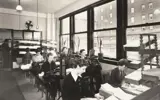ReSpace - Inspiring Commercial Space
Modernise Your Premises With Our Office Design And Space Planning
The style of offices often reflects world events and the current work culture, making it one of the most fascinating areas of interior design.
The pandemic, for instance, has definitely had an impact on our work culture. Changing technology has also had a significant influence on office design and space planning, and will continue to do so.
Offices have come a long way since the early 20th century. As you’ll see from old movies, for decades they were often austere environments. Thanks to the rise in the number of office workers over the past 100 years, this type of working environment has undergone many changes. During the two world wars, for instance, an industrial style look became more popular.
In the 1920s offices were often places with plain, mass produced furniture and typewriters, with little attention placed on the wellbeing of staff. That’s in stark contrast to modern offices which put emphasis on the wellness of employees.
In the first half of the 20th century, the hierarchy of the office was often of importance. Space planning back then meant those higher up worked in private offices from which they could watch subordinate staff. However, it wasn’t long before it was realised that such dynamics didn’t encourage productivity.
In the 1920s and 1930s art deco also came to have an influence on office design. Particularly in the USA, this meant more contemporary aesthetics, fine craftsmanship and the use of expensive materials.
In the 1960s, open plan offices and partitions were more common to give people privacy. Back then, it was still common for people to smoke and drink at work, as you’ll see from watching an episode of Mad Men!
Ergonomic office design arguably first appeared in the 1970s when individual workers were given more freedom to work independently and creatively. This was a period typified by long lunches, staff chatting by the water cooler, and frequent cigarette breaks. 1970s fashion also made its way into the office through the use of colours and patterns.
Steve Job’s obsession with bringing together art and technology was reflected in the Apple offices in the 2000s.
Next month, it will be three years since the beginning of the Covid-19 pandemic. During that time companies have had to adapt to changes like rises in hybrid working.
With the pandemic seemingly past the worst, it’s a good time to update your office for your current working conditions. Investing in your office space is an excellent way to boost morale, attract new clients and future-proof your building.
An attractive, well-designed office will impress both staff and clients. Ideally, it should be welcoming, functional and continually inspiring on a daily basis. It should also be easy to maintain and keep clean. Many companies also look to make their corporate space more sustainable and affordable to run.
Forbes has described the modern office as ‘defying easy categorisation’. So, how do you get started with your office design and space planning?
Hire ReSpace and we will provide plenty of creative ideas for your space. We love working with companies of all sizes to transform their office. Our team creates inspiring, creative and sustainable spaces that help you work more efficiently.
From the inventive use of materials and stylish furniture, to ensure your layout reflects your needs, we cover all elements of the process.
Many companies now want an office that feels like a home-from-home, but also offer benefits that remote working cannot.
Discover more reasons to pick our office design and space planning. Or don’t hesitate to contact our team for more information.

